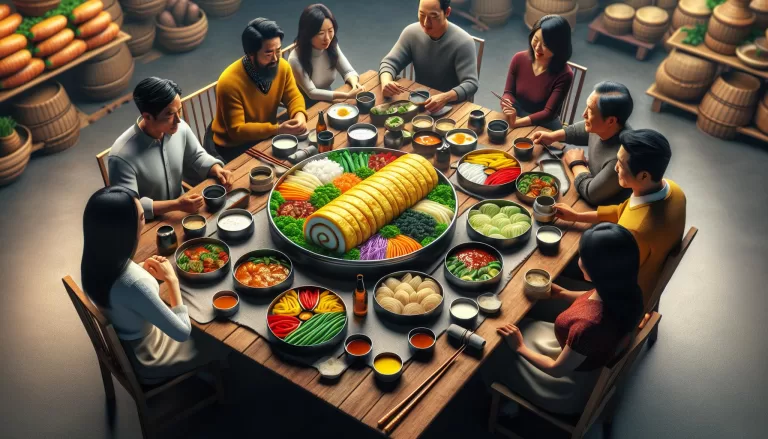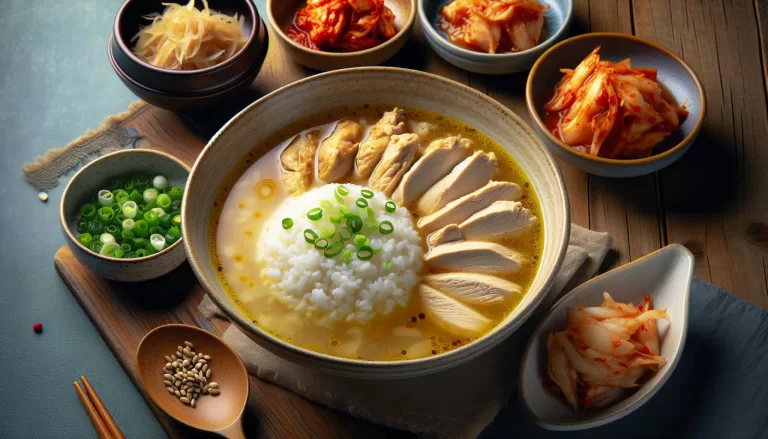Easy Homemade Dwaeji Galbikalbi Korean Pork Recipe for a Perfect BBQ Feast

Ingredients for Homemade Dwaeji Galbikalbi
Arming yourself with quality ingredients is the first step towards a great meal. Let’s dive into the items that’ll make an authentic Korean BBQ pork ribs dish.
Your shopping list for dwaeji galbikalbi includes the following key ingredients:
- 2 pounds of pork spare ribs: The backbone of your dish, ensure they’re fresh and of high-quality.
- 1 Asian pear: Yes, you heard it right! This unexpected ingredient adds a wonderful sweetness complementing the dish’s overall savory flavor.
- 1/2 cup of soy sauce: This imparts the familiar tang that’s expected in Korean cuisine.
- 3 tablespoons of brown sugar: Balancing the soy sauce’s saltiness, brown sugar provides a bit of sweetness.
- 3 tablespoons of gochujang: This Korean red pepper paste gives your meal the heat it deserves.
- 1 tablespoon of mirin: This sweet rice wine adds another layer of complexity to your flavors.
- 4 cloves of garlic: Essential for any Korean dish, you can’t go without.
For a unique twist, consider replacing brown sugar with coconut sugar. It will offer a catchy caramel note. Mixing ingredients like these can turn your everyday dish into a culinary delight.
Give a thought also on some optional garnishes:
- Sliced scallions and sesame seeds: These will add that beautiful color and extra crunch.
Dwaeji galbikalbi’s nutritional punch is particularly strong, especially due to its protein content from the pork ribs. It also provides lesser-known health benefits through ingredients like Asian pear, known for its Vitamin C and antioxidant properties.
Step-by-Step Instructions

Now that you’ve gathered your ingredients, let’s dive straight into the cooking process of this mouthwatering dish. Follow these steps, and you’ll soon be indulging in your very own Korean BBQ pork ribs – Dwaeji Galbikalbi style.
- Start off by preparing your pork spare ribs. To do this, you’ll want to rinse them under cold water, then pat them dry with a paper towel.
- Next, prepare your marinade. In a large bowl, combine your marinade ingredients. These should include your grated Asian Pear, soy sauce, brown sugar or coconut sugar for an extra unique twist, gochujang, mirin, and your minced garlic.
- Once you’ve mixed together these ingredients, add your pork spare ribs. Ensure that the ribs are well coated. Let them marinate in the refrigerator for at least 3 hours, but ideally overnight if you’re able to plan ahead.
- After marinating, it’s time to get grilling. Heat up your barbecue, and once it’s hot enough, add your ribs. Grill them for approximately 3-5 minutes on each side, or until you see that delicious charred effect we all know and love from Korean BBQ.
- Once the ribs are cooked, you’re almost set for the feast. Place your grilled ribs on a serving platter, and sprinkle some chopped scallions and sesame seeds over the top. This garnish isn’t just for looks – it’s the tangy twist that’ll keep your tastebuds wanting more.
And there you have it! Your very own, home-cooked, absolutely succulent Dwaeji Galbikalbi. Serving this along with a fresh salad or some hot steamed rice will truly make for a complete Korean meal experience. The protein content of these pork ribs paired with the health benefits of ingredients like the Asian pear will contribute a wholesome goodness to your diet.
Tips for Marinating the Pork

The secret to succulent dwaeji galbikalbi lies in the marinade. So, let’s dive into useful tips to ensure the pork ribs absorb that sensational Korean flavor.
Choose high-quality ribs: pork spare ribs are ideal for this dish. They’ve got the perfect ratio of meat to fat, ensuring a juicy outcome.
Wash the ribs before marinating: this may seem like a no-brainer, but it’s an often-forgotten step. Rinse your ribs under cold water to get rid of bone fragments and residual blood. Pat them dry afterwards.
Using the right ingredients for your marinade is critical. Your list should include Asian pear (adds subtle sweetness and helps tenderize the meat), soy sauce (brings that umami flavor), and gochujang (offers a sweet and spicy kick).
Be generous with your marinade: the more you use, the more flavors your pork will absorb.
Marinating time matters: for dwaeji galbikalbi, the longer the better. The recommended time is 24 hours. This allows the marinade to penetrate the ribs completely, infusing every bite with flavor. Note that marinating too quickly won’t allow flavors to fully penetrate.
Rotate ribs occasionally: about halfway through the marinade process, give your ribs a good flip. This will ensure an even distribution of flavors.
Consider adding a grated kiwi to the marinade. It’s not usually included in traditional recipes but it does an excellent job tenderizing the meat due to its natural enzyme, actinidin. It’ll add a unique twist to your dish.
| Key Ingredients in Marinade | Role |
|---|---|
| Asian pear | Adds sweetness and helps tenderize meat |
| Soy sauce | Adds umami flavor |
| Gochujang | Gives a sweet and spicy kick |
| Optional: Grated kiwi | Helps tenderize meat |
As you continue your Korean cooking journey, remember these tips for marinating. They’re the gateway to a flavorful, mouthwatering dwaeji galbikalbi. The journey does not end here, as grilling is equally important…
Grilling the Dwaeji Galbikalbi
Now that your ribs have had ample time to bathe in the rich, flavor-infusing marinade, it’s time to move onto the grilling. The essence of Korean BBQ isn’t just the marinade, but the way the meat’s grilled. No ordinary grill will do – a charcoal or wood burning grill is your best bet for achieving that authentic, smoky Korean bbq flavor.
Fire up your grill, aiming for medium – high heat. Looking for a temperature gauge? Aim for around 375°F. If you’re using a charcoal grill, make sure the coals are glowing a fiery red. That’s a telltale sign you’re good to go.
Throw those marinated ribs onto the grill. Patience is key here. Resist the urge to flip constantly. Give each side at least 5 – 7 minutes. That’s optimal for caramelizing that marinated outer layer and creating a lovely sear. The endgame? Succulent ribs with a crispy, charred exterior.
Dealing with a flare-up? Don’t flap a towel or blow on it. Simply move your ribs to a different part of the grill until it dies down. It’s normal, by the way. Those sugars in your marinade caramelizing and the fatty drippings ignite quite easily. Remember, you’re in control.
This grilling process could take anywhere from 20-30 minutes, depending on your grill heat and the thickness of your ribs.
An extra bit of help? Basting. Yes, basting and grilling go hand in hand. Baste the ribs generously with leftover marinade during the last 10 minutes of grilling. It’ll keep those ribs moist, sweet, and incredibly flavorful.
Your end goal should always be grilling until you’ve reached your desired tenderness and level of char, but remember to keep an eye out for safety. The USDA recommends pork reaches an internal temperature of 145°F – ensuring the meat is cooked through and music to a food safety specialist’s ears.
Remember, don’t rush your grilling. Let those ribs take their time, it’ll all be worth the wait! When they’re finally off the grill and resting for a minute or two, there’s one final touch. Sprinkle them with some sesame seeds for an extra kick of nutty flavor and a lovely presentation.
Serving and Presentation

Slice and Serve
Now that your Dwaeji Galbikalbi is at the perfect tenderness and char level, it’s time to carve it into bite-sized pieces. Be sure your knife is sharp to prevent tearing the meat. Remember: clean cuts ensure a visually appealing dish.
The Art of Plating
Presentation plays a crucial role in Korean cuisine. Start by arranging the sliced pork on a serving platter. Build an aesthetic layout with the succulent pieces of meat being the focus. Layer these pieces in an overlapping semi-circle and your platter is half-way there.
Garnish with Care
Take the time to garnish your dish beautifully. A well-garnished dish not only enhances its visual appeal but also boosts the overall dining experience. Here’s what you do:
- Add slices of fresh green lettuce for a splash of color.
- Sprinkle your previously toasted sesame seeds liberally.
- Include colorful Korean side dishes known as ‘banchan’ to elevate your serving plate.
- If you’re feeling adventurous, try adding other garnishes like fried garlic chips, or thinly sliced green onions.
Accompaniments Make a Difference
Consider serving residency-filtered soju, a traditional Korean alcoholic beverage, or other complementary drinks. Delight your guests further with array of side dishes and dips. Kimchi and Gochujang-based dips pair exceptionally well with Dwaeji Galbikalbi.
Serving Tip
Korean BBQ is often a communal dining experience. Set up a grilling station at your dining table and involve your guests in the jubilant act of grilling. It’s not just about the food, it’s about the whole experience. Encourage everyone at the table to participate, grill their own, and indulge in the mouth-watering Dwaeji Galbikalbi.
So go ahead, take these tips, and prepare a feast that’ll be remembered for its perfect blend of flavors, textures, and presentation. You’re well on your way to becoming the ultimate Korean barbeque master.
Conclusion
So, you’ve got the lowdown on how to whip up a stunning Dwaeji Galbikalbi feast. Now it’s your turn to put these tips into action. Remember, the key to a perfect Korean BBQ isn’t just about the food. It’s about the experience. So, slice that pork with care, plate it up beautifully, and don’t forget those side dishes. And of course, pour that soju! It’s all part of the communal dining experience that makes Korean BBQ so special. So, go ahead and create a memorable feast that’s a blend of incredible flavors, textures, and presentation. Your guests will thank you.




